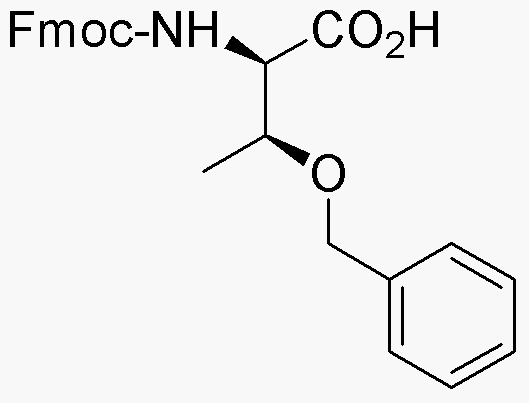Fmoc-O-benzyl-D-threonine is widely utilized in research focused on:
- Peptide Synthesis: This compound serves as a protective group in the synthesis of peptides, allowing for selective reactions and improving yield and purity in complex sequences.
- Drug Development: It plays a role in the design of peptide-based pharmaceuticals, particularly in creating more stable and effective drug candidates for various therapeutic areas.
- Bioconjugation: The compound is used in bioconjugation processes, facilitating the attachment of biomolecules to surfaces or other molecules, which is crucial in diagnostics and targeted therapies.
- Research in Protein Engineering: Its application in the modification of amino acids aids researchers in studying protein structure and function, enhancing our understanding of biological processes.
- Custom Synthesis Services: Many companies offer custom synthesis of this compound, catering to specific research needs, which provides flexibility and tailored solutions for scientists.
General Information
Properties
Safety and Regulations
Applications
Fmoc-O-benzyl-D-threonine is widely utilized in research focused on:
- Peptide Synthesis: This compound serves as a protective group in the synthesis of peptides, allowing for selective reactions and improving yield and purity in complex sequences.
- Drug Development: It plays a role in the design of peptide-based pharmaceuticals, particularly in creating more stable and effective drug candidates for various therapeutic areas.
- Bioconjugation: The compound is used in bioconjugation processes, facilitating the attachment of biomolecules to surfaces or other molecules, which is crucial in diagnostics and targeted therapies.
- Research in Protein Engineering: Its application in the modification of amino acids aids researchers in studying protein structure and function, enhancing our understanding of biological processes.
- Custom Synthesis Services: Many companies offer custom synthesis of this compound, catering to specific research needs, which provides flexibility and tailored solutions for scientists.
Documents
Safety Data Sheets (SDS)
The SDS provides comprehensive safety information on handling, storage, and disposal of the product.
Product Specification (PS)
The PS provides a comprehensive breakdown of the product’s properties, including chemical composition, physical state, purity, and storage requirements. It also details acceptable quality ranges and the product's intended applications.
Certificates of Analysis (COA)
Search for Certificates of Analysis (COA) by entering the products Lot Number. Lot and Batch Numbers can be found on a product’s label following the words ‘Lot’ or ‘Batch’.
Numéro de catalogue
Numéro de lot/série
Certificates Of Origin (COO)
This COO confirms the country where the product was manufactured, and also details the materials and components used in it and whether it is derived from natural, synthetic, or other specific sources. This certificate may be required for customs, trade, and regulatory compliance.
Numéro de catalogue
Numéro de lot/série
Safety Data Sheets (SDS)
The SDS provides comprehensive safety information on handling, storage, and disposal of the product.
DownloadProduct Specification (PS)
The PS provides a comprehensive breakdown of the product’s properties, including chemical composition, physical state, purity, and storage requirements. It also details acceptable quality ranges and the product's intended applications.
DownloadCertificates of Analysis (COA)
Search for Certificates of Analysis (COA) by entering the products Lot Number. Lot and Batch Numbers can be found on a product’s label following the words ‘Lot’ or ‘Batch’.
Numéro de catalogue
Numéro de lot/série
Certificates Of Origin (COO)
This COO confirms the country where the product was manufactured, and also details the materials and components used in it and whether it is derived from natural, synthetic, or other specific sources. This certificate may be required for customs, trade, and regulatory compliance.


